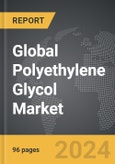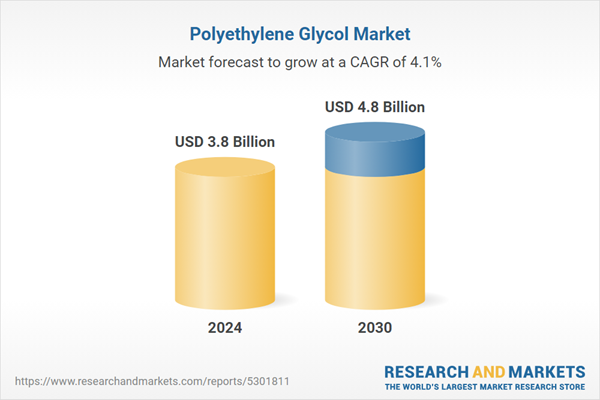Global Polyethylene Glycol Market - Key Trends and Drivers Summarized
Why Is Polyethylene Glycol So Essential Across Diverse Industries?
Polyethylene Glycol (PEG) is a versatile compound that has found widespread use in numerous industries, ranging from pharmaceuticals and cosmetics to industrial manufacturing and food production. Its unique properties, such as solubility in both water and organic solvents, make it a highly adaptable material for various applications. In the pharmaceutical industry, PEG serves as a critical excipient, used to enhance the solubility and bioavailability of drugs, making it easier for the body to absorb medications. It is also employed in the production of drug delivery systems, such as tablets and capsules, where it helps control the release of active ingredients. Beyond pharmaceuticals, PEG is widely used in personal care products like lotions, shampoos, and creams due to its ability to act as a humectant, drawing moisture to the skin and improving texture. Its non-toxic and biocompatible nature further enhances its appeal in medical applications, such as in laxatives and skin ointments. Additionally, its presence in food products as a stabilizer, thickener, and anti-foaming agent demonstrates PEG's versatility across industries, providing critical functionality in various formulations.What Are the Unique Properties That Make Polyethylene Glycol Stand Out?
Polyethylene Glycol's distinctive chemical properties make it a highly valued compound in both industrial and consumer applications. One of the primary attributes of PEG is its broad solubility profile - it can dissolve in water, alcohols, and other organic solvents, making it an effective medium for delivering active ingredients in pharmaceuticals and personal care products. Its molecular weight can also be modified, allowing PEG to perform differently depending on the needs of specific applications. For instance, low molecular weight PEGs are often used as solvents or plasticizers, while higher molecular weights offer viscosity and stability, making them ideal for use in creams, lubricants, and coatings. PEG is also known for its lubricating properties, which are crucial in industrial applications like machinery, where it reduces friction and wear. Additionally, PEG's non-ionic and biocompatible nature ensures that it is non-reactive and safe for use in products that come into contact with the human body, such as pharmaceuticals, medical devices, and cosmetics. These properties not only make PEG a go-to ingredient for many products but also ensure its continued relevance across various scientific and industrial developments.Why Is Polyethylene Glycol an Attractive Option for Manufacturers?
Manufacturers in a wide range of sectors are increasingly turning to Polyethylene Glycol due to its versatility, efficiency, and ease of use. In the pharmaceutical industry, PEG is highly valued for its role in enhancing the solubility and stability of drugs, especially in formulations that require controlled release mechanisms. Its ability to form hydrogels also makes it a key material in drug delivery systems and tissue engineering. In personal care products, manufacturers appreciate PEG for its emulsifying and moisturizing properties, allowing for the smooth blending of ingredients in creams, lotions, and other cosmetics. The food industry uses PEG as a stabilizer and thickener in products such as ice creams, sauces, and beverages, where it helps maintain consistency and prevent separation. Additionally, PEG's lubricating and anti-static properties make it indispensable in industrial applications, such as in the formulation of lubricants and antifreeze solutions. Its non-toxicity and biodegradability make it an environmentally friendly option, aligning with the growing demand for sustainable manufacturing practices. Moreover, PEG's ease of synthesis and availability in different grades and molecular weights provide manufacturers with flexibility in designing products tailored to specific performance needs, making it a highly practical choice across various sectors.What Is Driving the Growth of the Polyethylene Glycol Market?
The growth in the Polyethylene Glycol market is driven by several factors that are reshaping its use across industries. One of the most significant drivers is the rising demand in the pharmaceutical industry, where PEG is used to improve drug formulations, particularly for biologics and specialty medications. As the pharmaceutical sector continues to expand, especially with advancements in biologics and personalized medicine, the demand for PEG-based excipients and drug delivery systems is increasing. In the cosmetics and personal care market, the trend toward natural and biocompatible ingredients has further boosted the demand for PEG due to its moisturizing, emulsifying, and stabilizing properties. Another key factor is the growing application of PEG in the food industry, where it is used as a stabilizer and texturizer in processed foods and beverages. Additionally, the rise in industrial applications, including the need for more efficient lubricants, coatings, and anti-foaming agents, is driving PEG's use in sectors like manufacturing, chemicals, and textiles. The growing emphasis on environmentally friendly and biodegradable materials is also contributing to PEG's popularity, as manufacturers across industries look to adopt sustainable practices. Finally, ongoing research into the medical and biotechnological applications of PEG, such as in hydrogels for wound care and drug delivery, is likely to open new avenues for growth in the coming years, solidifying PEG's role as a critical material in diverse applications.Report Scope
The report analyzes the Polyethylene Glycol market, presented in terms of market value (US$ Thousand). The analysis covers the key segments and geographic regions outlined below.- Segments: Form (Flake / Powder From, Liquid Form, White Wax Solid Form); Application (Pharmaceutical Application, Industrial Application, Cosmetics & Personal Care Application, Food & Beverage Application, Other Applications).
- Geographic Regions/Countries:World; United States; Canada; Japan; China; Europe (France; Germany; Italy; United Kingdom; Spain; Russia; and Rest of Europe); Asia-Pacific (Australia; India; South Korea; and Rest of Asia-Pacific); Latin America (Argentina; Brazil; Mexico; and Rest of Latin America); Middle East (Iran; Israel; Saudi Arabia; United Arab Emirates; and Rest of Middle East); and Africa.
Key Insights:
- Market Growth: Understand the significant growth trajectory of the Flake / Powder Form segment, which is expected to reach US$2.4 Billion by 2030 with a CAGR of a 4.6%. The Liquid Form segment is also set to grow at 3.8% CAGR over the analysis period.
Why You Should Buy This Report:
- Detailed Market Analysis: Access a thorough analysis of the Global Polyethylene Glycol Market, covering all major geographic regions and market segments.
- Competitive Insights: Get an overview of the competitive landscape, including the market presence of major players across different geographies.
- Future Trends and Drivers: Understand the key trends and drivers shaping the future of the Global Polyethylene Glycol Market.
- Actionable Insights: Benefit from actionable insights that can help you identify new revenue opportunities and make strategic business decisions.
Key Questions Answered:
- How is the Global Polyethylene Glycol Market expected to evolve by 2030?
- What are the main drivers and restraints affecting the market?
- Which market segments will grow the most over the forecast period?
- How will market shares for different regions and segments change by 2030?
- Who are the leading players in the market, and what are their prospects?
Report Features:
- Comprehensive Market Data: Independent analysis of annual sales and market forecasts in US$ Million from 2024 to 2030.
- In-Depth Regional Analysis: Detailed insights into key markets, including the U.S., China, Japan, Canada, Europe, Asia-Pacific, Latin America, Middle East, and Africa.
- Company Profiles: Coverage of players such as BASF, Croda, Dow Chemical Company, Huangma Chemical, India Glycols and more.
- Complimentary Updates: Receive free report updates for one year to keep you informed of the latest market developments.
Some of the 48 companies featured in this Polyethylene Glycol market report include:
- BASF
- Croda
- Dow Chemical Company
- Huangma Chemical
- India Glycols
- Ineos
- Jiangsu Haian Petrochemical Plant
- Liaoning Kelong
- Liaoning Oxiranchem
- Lotte Chemical
This edition integrates the latest global trade and economic shifts into comprehensive market analysis. Key updates include:
- Tariff and Trade Impact: Insights into global tariff negotiations across 180+ countries, with analysis of supply chain turbulence, sourcing disruptions, and geographic realignment. Special focus on 2025 as a pivotal year for trade tensions, including updated perspectives on the Trump-era tariffs.
- Adjusted Forecasts and Analytics: Revised global and regional market forecasts through 2030, incorporating tariff effects, economic uncertainty, and structural changes in globalization. Includes historical analysis from 2015 to 2023.
- Strategic Market Dynamics: Evaluation of revised market prospects, regional outlooks, and key economic indicators such as population and urbanization trends.
- Innovation & Technology Trends: Latest developments in product and process innovation, emerging technologies, and key industry drivers shaping the competitive landscape.
- Competitive Intelligence: Updated global market share estimates for 2025, competitive positioning of major players (Strong/Active/Niche/Trivial), and refined focus on leading global brands and core players.
- Expert Insight & Commentary: Strategic analysis from economists, trade experts, and domain specialists to contextualize market shifts and identify emerging opportunities.
Table of Contents
Companies Mentioned (Partial List)
A selection of companies mentioned in this report includes, but is not limited to:
- BASF
- Croda
- Dow Chemical Company
- Huangma Chemical
- India Glycols
- Ineos
- Jiangsu Haian Petrochemical Plant
- Liaoning Kelong
- Liaoning Oxiranchem
- Lotte Chemical
Table Information
| Report Attribute | Details |
|---|---|
| No. of Pages | 291 |
| Published | January 2026 |
| Forecast Period | 2024 - 2030 |
| Estimated Market Value ( USD | $ 3.8 Billion |
| Forecasted Market Value ( USD | $ 4.8 Billion |
| Compound Annual Growth Rate | 4.1% |
| Regions Covered | Global |









